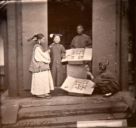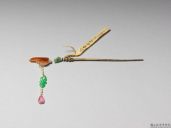Flowering up
Part of the beauty of the Manchurian female hairstyle came from the beautiful decorations that were added, such as flowers. The practice of putting flowers in one’s hair was most likely adopted from Han Chinese theatrical troupes in Hubei and Anhui, of which the Qing court was very fond.[Cf, p 179] This was already practised in the 18th century, as can be seen in this quote describing a Manchurian woman preparing herself:
With skilled hands the aunt undid her jet-black hair, A tortoise-shell comb in her grasp. She combed and straigthened, straigthened and combed; When her hair was all combed, she put cassia oil in the tresses. Ribbons of shiny black artfully supported the now-dressed hair, Golden ear-picks of pure yellow pinned it sideways.(...) In the part of her hair, ever so narrow, she traced perfumed powder, The hair on the temples, cut ever so neatly, she daubed with light ink, Her fine and delicate eyebrows she lined with a silver hairpin, While glittering pearl earrings dangled down, three on a side; A modish, large flower she fastened in her hair, Along with many different hairpins all over her head. [Cf, p 275]
Each of the decorations put into the liangbatou and dalachi had its own name. The generic term for a hairpin was ji 笄. A ji would be given to every Chinese fifteen-year-old girl, which represented her having reached the marriageable age.[Cf] The ji came in many forms. The material used, be it jade, gold, ivory, or wood, showed off the wealth of the wearer.[Ibid] The normal hairpins, called zan 簪, often resembled flowers or one of the twelve Chinese zodiac animals. Another famous type of hairpin was the buyao 步摇. This hairpin was often made in the shape of a dragon or a phoenix and would move when the wearer walked, hence the name.[Ibid] Often in summer time, fresh flowers were also added to the liangbatou. Empress Dowager Cixi was very fond of wearing such flowers and would always put some in her hair.
I brought the boxes to her room and placed them on the table. She opened the first one and it contained a most beautiful peony made of coral and jade and each petal trembled like a real flower. This flower was made by stringing the petals which were made of coral on very fine brass wire, also the leaves which were made of pure jade. She took this flower and placed it on the right side of her headdress. Then she opened another box and took from it a magnificent jade butterfly made in the same way. This was an invention of her own and it was done by carving the coral and jade into petals and leaves and boring holes in the lower ends through which brass wire was run. [Cf, p 66]
Besides hairpins and fresh flowers, Manchu women would also hang ornaments on the sides of their liangbatou. These were often precious stones like pearls, or silk tassels.[Cf, p 190] The pearls and tassels were also used for decorative purposes and to show off the wealth and status of the wearer. Another ornament that was used often was the kingfisher hairpin, or diancui 点翠. Kingfishers are blue birds mostly found in Vietnam and Southern China. These birds generally represent sexual enjoyment and conjugal happiness.[Cf, p 186] Kingfisher feathers are used for many decorative purposes in China, and using these feathers is almost an art form in itself. The court ladies were very fond of the kingfisher feather hairpins, perhaps due to the symbolism behind the feathers of this blue, swallow-like bird.





